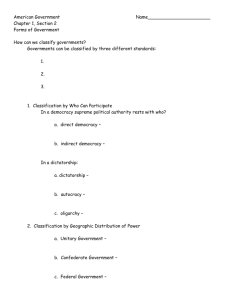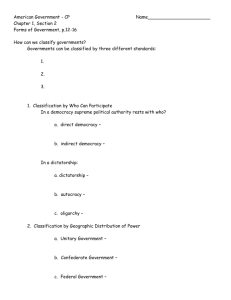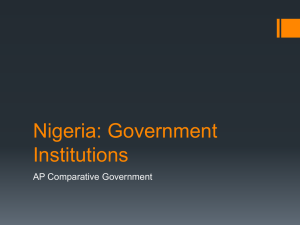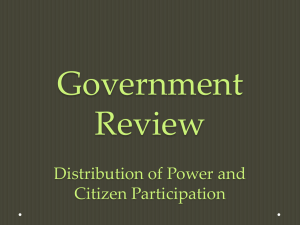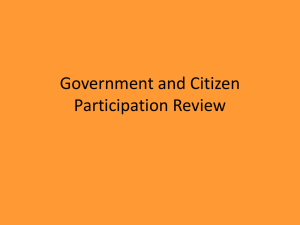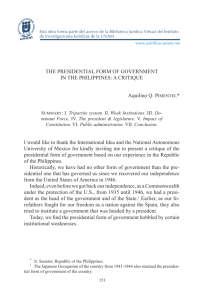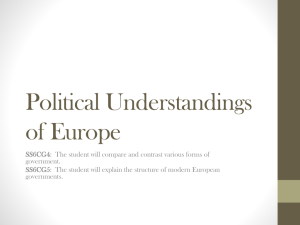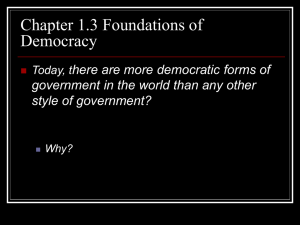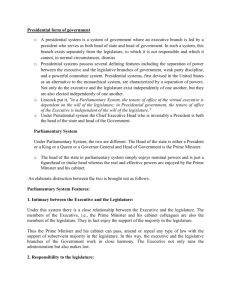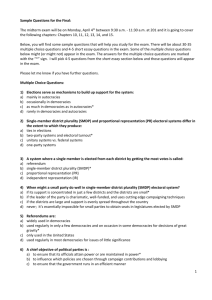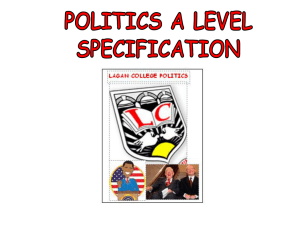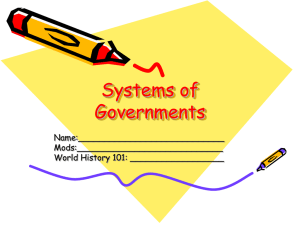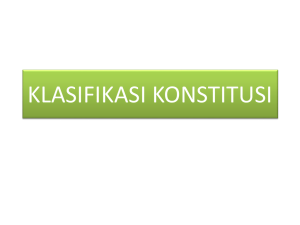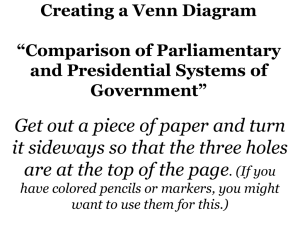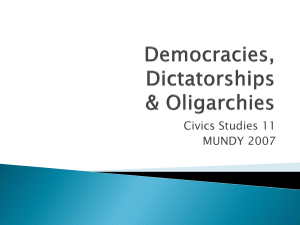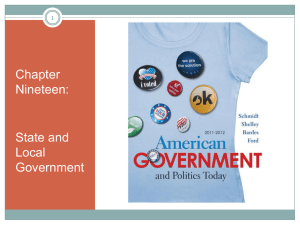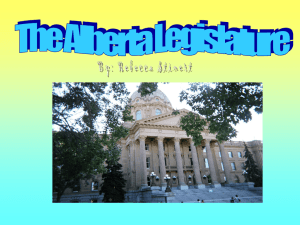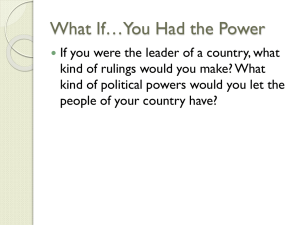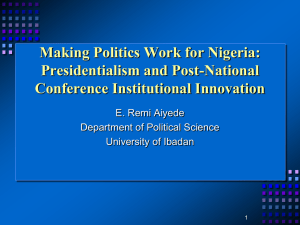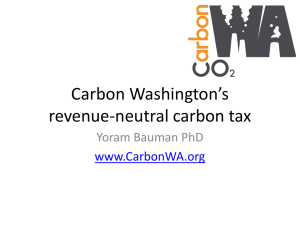PPT - OGT Terms 62-71
advertisement
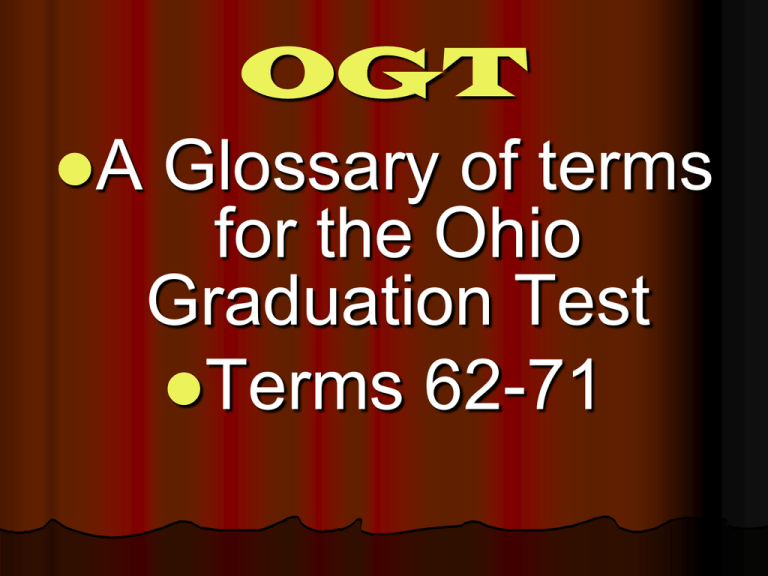
OGT A Glossary of terms for the Ohio Graduation Test Terms 62-71 NAACP (National Association for the Advancement of Colored People) African American organization formed to fight for civil rights. NAACP lawyers brought the Brown v. Board of Education case to the Supreme Court.(82) In 1964, President Lyndon Johnson persuaded Congress to pass the Civil Rights Act, which outlawed racial discrimination in public places, such as theaters, cafeterias and hotels. This was an attempt to A. maintain poll taxes for AfricanAmericans. B. stop African-American northward migration. C. end segregation legalized by Jim Crow laws. D. segregate public busing in major American cities. C 2008 Test Question What was one perspective of African-Americans that was reflected in the founding of the National Association for the Advancement of Colored People (NAACP)? A. the desire to preserve cultural traditions B B. the desire to end racial discrimination C. the belief that segregation was necessary to maintain social order D. the belief that collective bargaining would lead to higher incomes 2009 Test Question What was one perspective of African-Americans that was reflected in the founding of the National Association for the Advancement of Colored People (NAACP)? A. the hope of encouraging widespread emigration to Africa B. the belief that racial segregation was justified in all circumstances C. the goal of forming a new political party to represent AfricanAmericans D. the desire to bring about legal and social equality for AfricanAmericans D NAFTA (North American Free Trade Agreement) An agreement among the United States, Canada and Mexico. Customs duties on goods from within the region are lower than they are for goods outside it. (96) The North American Free Trade Agreement (NAFTA) is a treaty designed to remove tariffs and other trade barriers between Canada, Mexico and the United States. This helped establish an economic region among those nations because A. participants enlarged their dependence on domestic markets. B. participants terminated trade relationships with other regions. C. participants imposed tariffs on goods imported from other countries. D. trade among participants increased, making their economies more interdependent. D NATIONALISM The belief that each ethnic group or “nationality” is entitled to its own government and national homeland. (43) NATO (North Atlantic Treaty Organization) A military alliance between the United States, Canada, and Western European nations to defend against Communism. (53) NAZISM German political movement led by Adolf Hitler, based on the principles of dictatorship, violence and aggression. (46) NEW DEAL Programs introduced by President Franklin D. Roosevelt to fight the Great Depression; the New Deal included social and economic programs to lower unemployment and regulate the economy. (68) NEW DEAL NINETEENTH AMENDMENT A constitutional amendment in 1920 that guaranteed women the right to vote. (66) This cartoon could be used to support the thesis that opposition to women’s suffrage was A. based on unemployment statistics comparing men and women. B. stronger among women than among men. C. stronger in western states than in eastern states. D. based on stereotyping of women’s roles. D 2008 Question Although the 14th Amendment to the Constitution extended the rights of citizenship to “all persons” born or naturalized in the United States, discrimination on the basis of gender still existed throughout much of the country during the late 1800s. Which was consequence of this discrimination? A. the end of the military draft for women B. the growth of the women’s suffrage movement C. the beginning of sit-ins to desegregate lunch counters B D. the continuation of efforts to end university admissions quotas 2009 Question The United States Constitution is a living document that changes over time as a result of amendments and Supreme Court decisions. How did the Constitution change as a result of the 19th Amendment? A. The voting rights of women were expanded. B. The civil rights of Native Americans were restricted. C. The civil rights of African-Americans were protected. A D. The voting rights of property owners were expanded. PARLIAMENTARY DEMOCRACY A form of government in which voters elect the legislature (Parliament), and Parliament in turn chooses the chief executive (Prime Minister). (134) Voters Elect Legislature (Parliament) Chief Executive (Prime Minister) Judiciary PER CAPITA INCOME Average annual income of people in a country.(97) PRESIDENTIAL DEMOCRACY A form of government where there is a separation of powers between the legislature and chief executive. People elect legislators and the President. (134) Voters Elect Legislature (Congress) Chief Executive (President) Judiciary Par/Pres Dem. ???? Parliamentary Democracy Voters Elect Legislature (Parliament) Chief Executive (Prime Minister) Judiciary Presidential Democracy Voters Elect Legislature (Congress) C Chief Executive (President) Judiciary According to the information in the diagrams, what is the difference in the relationship between the executive and the legislature in the two types of democracies? A. In a presidential democracy, the executive is more accountable to the legislature. B. In a presidential democracy, the legislature is more accountable to the executive. C. In a presidential democracy, the executive and the legislature are directly accountable to the citizens. D. In a presidential democracy, the executive and the legislature are less accountable to the citizens. 2008 Question Citizens in presidential democracies and parliamentary democracies typically achieve governmental change by A. going on strike. B. voting in elections. C. serving in the military. D. engaging in revolution. B 2008 Question A group of citizens organizes a peaceful march through the streets of their nation’s capital. They carry signs calling for the nation’s leader to resign. Describe how likely this type of protest could be held in a presidential democracy and in a dictatorship. Explain the reason for these differences. Write your answer in the Answer Document. (2 points) 2009 Question What method is typically used by citizens in parliamentary and presidential democracies to achieve governmental change? A. elections B. revolution C. civil war D. secession A
